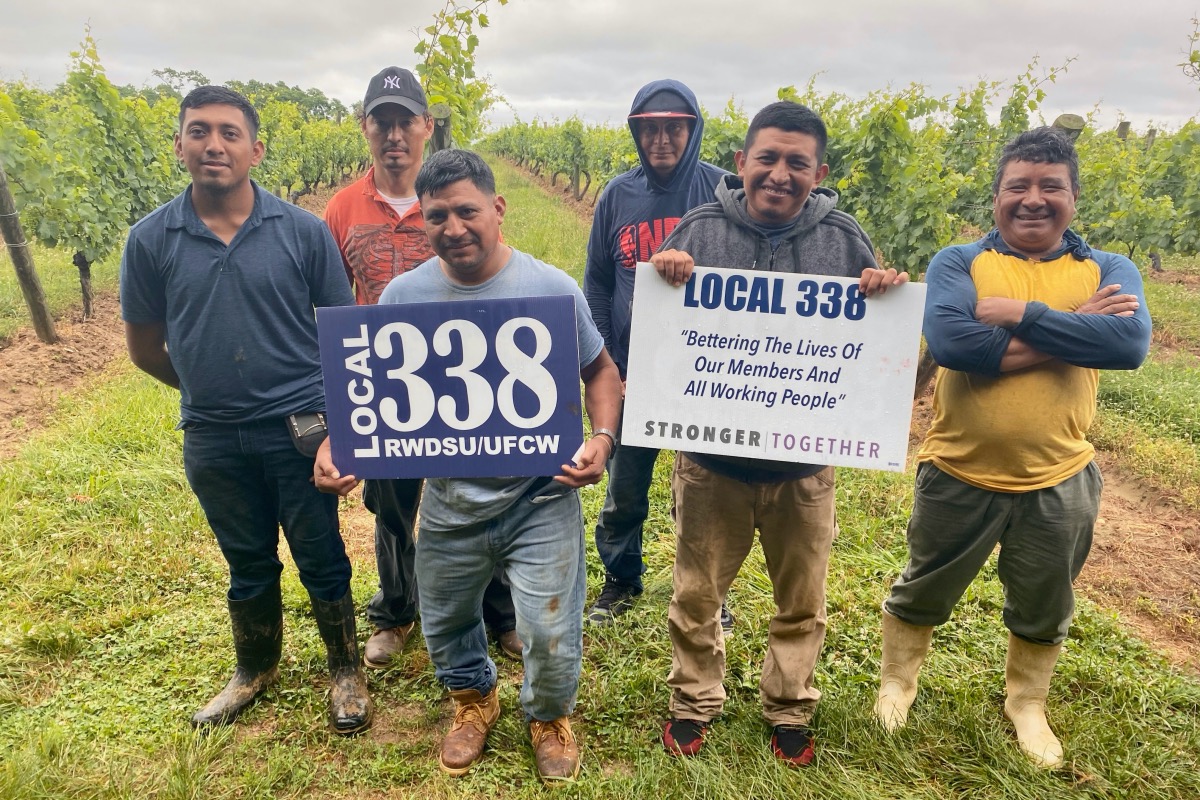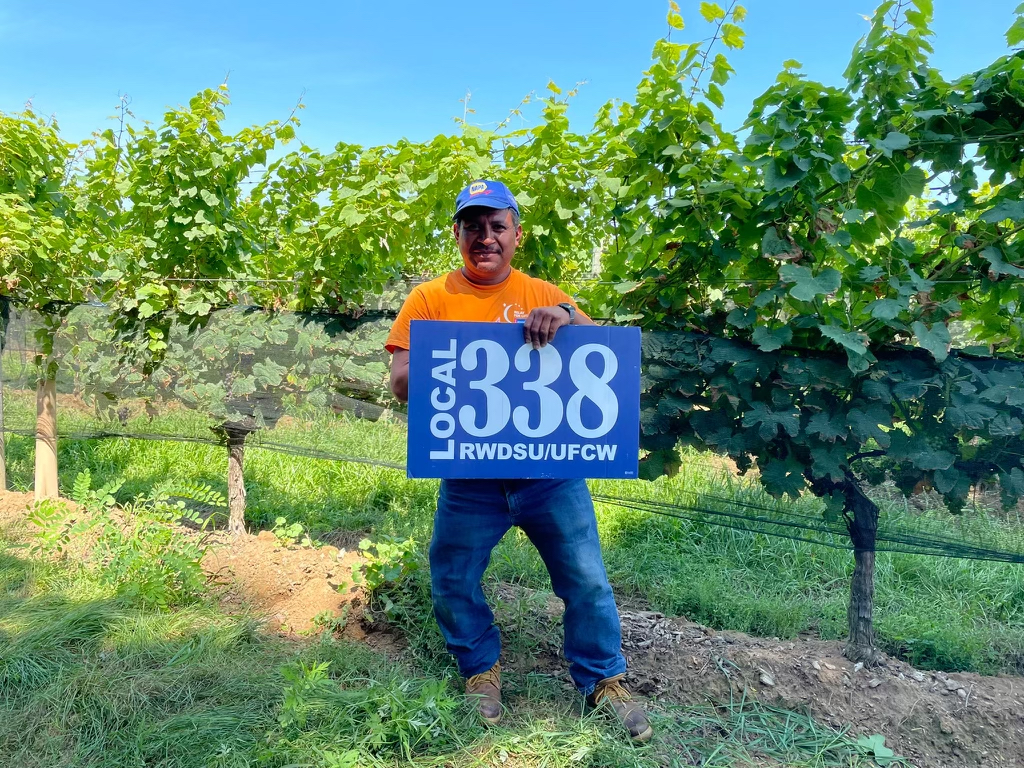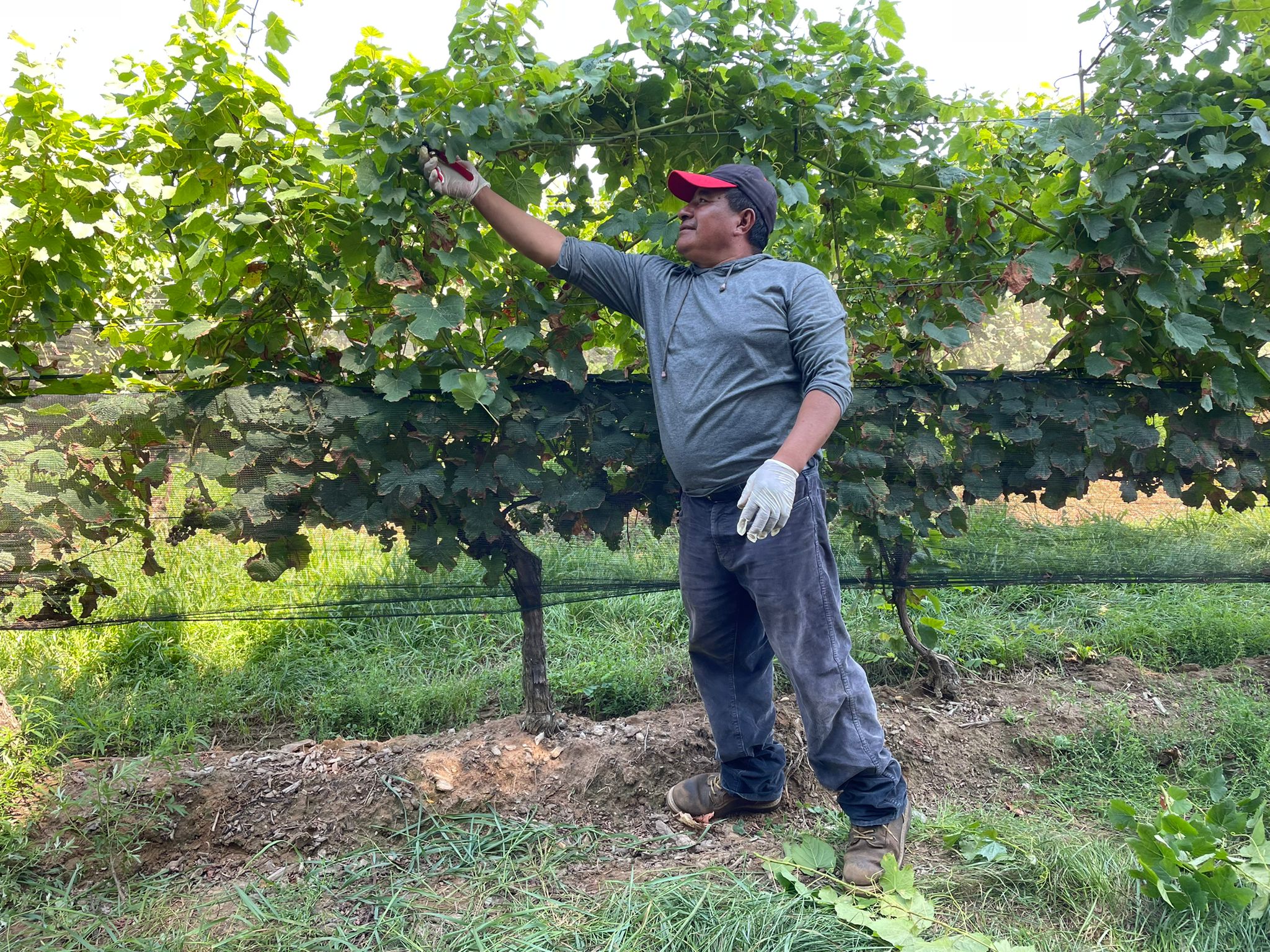

A group of 12 men, all from Guatemala and Honduras, have become the first farmworkers in New York to join a union. From left to right: Exaul Gregorio, Edin Mancilla, Jorge Ramírez, Marvin Díaz, Rony Agustin and Rodolfo Mendez. (Courtesy of Local 338)
LONG ISLAND, New York — In the spring of 2020, at the height of fear and uncertainty about the COVID-19 pandemic, Noemi Barrera found herself walking the fields of Long Island’s East End. Berrera, 34, wanted to see how farmworkers were faring amidst the pandemic.
“I was just doing it as a concerned citizen at first,” she said. “I started noticing workers gathered with no masks.”
Barrera and her friend Noemi Sanchez began passing out masks and hand sanitizer to agricultural workers. “I started developing relationships and trust,” said Barrera. “Little by little, I started telling them what kind of work I did.”
Barrera is a representative for Local 338 RWDSU/UFCW, a union that represents 13,000 workers across various industries in the state of New York. She began spending time with a group of 12 workers from Pindar Vineyards in Peconic, on their lunch breaks and after work. She told them about a new law that had gone into effect at the start of that year. The Farm Laborers Fair Labor Practices Act granted farmworkers overtime pay, a day of rest, and the right to organize.
Jorge Ramírez, 55, has worked at Pindar Vineyards for almost 18 years. He says that before the women visited, he had no idea they could join a union.
“They taught us what our rights were,” Ramírez said. “And I told the guys, ‘The vineyard doesn’t value us. They don’t take us into account. Enough already with all of this.’ So we decided to associate ourselves with Local 338.”
In September, the group of 12 became the first farmworkers in New York to join a union, a historic milestone in the decades-long struggle for farmworker rights.
“We feel happy, and thankful to God,” Ramírez said. “Now I feel we will be able to be respected, that our efforts will be recognized. Because this work is not easy.”


Jorge Ramirez stands in the fields where he has worked for nearly 18 years. (Courtesy of Local 338)
Unionizing offers pathways to securing many of the benefits long denied to agricultural workers, like paid time off and safer working conditions. But almost two years since they gained the right to collectively bargain, only 12 out of New York’s 56,000 farmworkers have joined a union. After decades of exclusion from basic labor rights, a lack of awareness about their legal protections and deeply ingrained hesitation still stand in the way of New York farmworker unionization.
The 1935 National Labor Relations Act and New York’s 1937 State Employment Relations Act excluded farmworkers from basic labor rights like overtime pay, a day of rest, and the right to organize. Both laws are vestiges of the Jim Crow era, when most agricultural workers were Black.
In 2019, a New York court of appeals deemed the state law unconstitutional. Then the state legislature passed the Farm Laborers Fair Labor Practices Act, guaranteeing farmworkers’ rights to collective bargaining, time off, and overtime pay, among other measures.
“It’s a very sad story with a great ending,” said State Sen. Jessica Ramos (D-Queens), who sponsored the bill. “I like to think we were able to rid New York of one of its original sins.”
But advocates said outreach about the law has been a challenge. The COVID-19 lockdown began just three months after the law went into effect, halting advocates’ ability to meet farmworkers in person.
“Workers are only just starting to learn what this means,” said Emma Kreyche, organizing and advocacy coordinator at Worker Justice Center of New York.
Advocates are also working to overcome hesitancy among farmworkers. Though it is now illegal for employers to dissuade workers from organizing, Kreyche said this behavior still happens with little oversight. “Employers see workers every day. They have a leg up on the messaging.”
“There’s a bunch of factors,” says Angel Reyes Rivas, Long Island coordinator for the Rural & Migrant Ministry. “The most important ones are their undocumented status, and the attitude of the employer.” About half of farmworkers in the United States are undocumented, according to the Department of Agriculture.
Mark A. Torres, a labor lawyer and the author of Long Island Migrant Labor Camps: Dust for Blood, said the most powerful benefit of unionization is the protection of a collective bargaining agreement. “You have the conditions of employment of a binding legal contract,” he said. “And that’s dramatic.”
“It gives workers an additional mechanism to ensure employers comply by law,” said Kreyche. “Too often, employers are in violation of the law with regards to things like health and safety, or overtime.”
Ramírez, who is from Guatemala, works as a sprayer and machine operator on the vineyard. He said that his day can last from 5 a.m. until 9 p.m. during the peak season. In the winter, he and his coworkers might work in the fields in temperatures as low as 20 degrees. He said he does not feel valued by his employer.
“Imagine, working somewhere almost 18 years and Christmas comes, the New Year comes,” said Ramirez. “And the boss doesn’t say to anyone, ‘Stay home, call your family, rest.’ Nothing.”
Pindar Vineyards did not respond to a request for comment.


Farmworker and union member Rodolfo Mendez (Courtesy of Local 338)
When contract negotiations begin, Pindar Vineyards workers plan to negotiate for paid holidays, sick days, and vacation as well as overtime.
Luis Jiménez, a dairy worker in Livingston County and the president of the farmworker rights group Alianza Agrícola, said he is paying attention to what Pindar Vineyards workers are able to negotiate.
“I think this will begin to grow a wave of farmworkers,” said Jiménez. “With more information and more education, they will be willing to take the risk [of organizing].”
Jiménez said he has been approached by three unions so far. But his dream is to start the first independent farmworker union in New York, having been inspired by independent farmworker unions in California and Washington State.
Union membership has been in decline since its peak in the 1950s. According to the Economic Policy Institute, only 12.1 percent of workers in the U.S. are union members, about half the rate of the 1980s. In New York, 22 percent of workers are in unions, according to the Bureau of Labor Statistics.
Even in California, the birthplace of farmworker unionization, only 6,240 of the state’s 407,000 farmworkers are part of United Farm Workers, the union founded by César Chávez, Dolores Huerta and others.
Still, the moment coincides with a resurgence of union activism across the country. Ten thousand John Deere workers went on strike last week over wages and retirement benefits. Fourteen thousand Kellogg workers have been on strike since October 5. Over the weekend, a strike of 60,000 TV and film workers was narrowly avoided through contract negotiations.
The pandemic has empowered essential workers to speak up, regardless of union membership, according to Saru Jayaraman, president of One Fair Wage and director of the Food Labor Research Center at the University of California, Berkeley. “In my 20 years of organizing, I have never seen such a willingness to organize, stand up, fight, and beyond anything else, say, ‘I refuse to work for these low wages anymore.’ ”
Back on Long Island, Barrera is trying to capitalize on the momentum. She said that Local 338 has another union petition pending with the state’s Public Employment Relations Board and is in conversations with workers at several other vineyards.
To other farmworkers following the Pindar Vineyards workers’ journey, Ramírez has a message. “Join us, and don’t be afraid,” he said.
“Others can sing victory like us. They can be respected like us.”
***
Gabriela Aoun is a writer and producer focused on the intersection of environmental and social issues. She is a Columbia Journalism School Class of 2022 master’s student and previously served as content director of the Adventure Sports Network. Twitter: @gabriela_aoun


